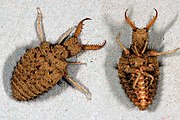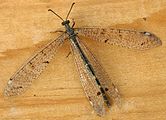Translations:Adventist Youth Honors Answer Book/Nature/Insects - Advanced/14/en
- The eggs are laid by the females during spring and summer breeding months.
- The eggs hatch, revealing worm-like larvae, the caterpillars. The caterpillars consume their egg cases, then feed on milkweed. During the caterpillar stage, monarchs store energy in the form of fat and nutrients to carry them through the non-feeding pupa stage.
- In the pupa or chrysalis stage, the caterpillar spins a silk pad on a twig, leaf, etc., and hangs from this pad by its last pair of prolegs. It hangs upside down in the shape of a 'J', and then molts, leaving itself encased in an articulated green exoskeleton. At this point, hormonal changes occur, leading to the development of a butterfly (metamorphosis). The chrysalis darkens (actually becomes transparent) a day before it emerges, and its orange and black wings can be seen.
- The mature butterfly emerges after about two pupal weeks and hangs from the split chrysalis for several hours until its wings are dry (often in the morning). Meanwhile fluids are pumped into the crinkled wings until they become full and stiff. Some of this orangey fluid (called meconium) drips from the wings. Finally (usually in the afternoon) the monarch spreads its wings, quivers them to be sure they are stiff, and then flies away, to feed on a variety of flowers, including milkweed flowers, red clover, and goldenrod.
Antlion
The life cycle of the antlion begins with oviposition (egg-laying). The female antlion repeatedly taps the sand surface with the tip of her abdomen. She then inserts her abdomen into the sand and lays an egg. The antlion larva is a ferocious-appearing creature with a robust, fusiform body, a very plump abdomen, the thorax bearing three pairs of walking legs. The prothorax forms a slender mobile "neck" for the large, square, flattened head, which bears an enormous pair of sicklelike jaws with several sharp, hollow projections. The jaws are formed by the maxillae and mandibles, which in each pincer enclose a canal for injecting venom between them. Depending on species and where it lives, the larvae will either hide under leaves or pieces of wood, in cracks of rocks, or dig pits in sandy areas.


